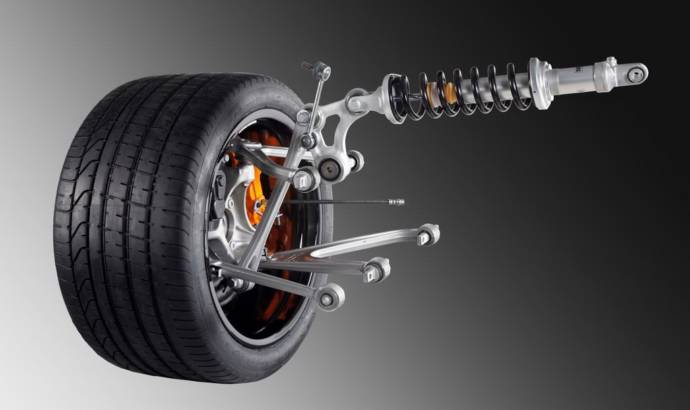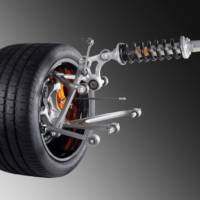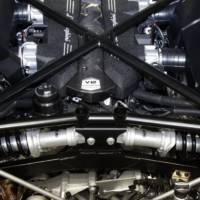As the next Lamborghini supercar which will most probably be called the Aventador, is approaching its debut day (Geneva Motor Show in March), the Italian manufacturer is releasing details with some of the mechanical features that have been improved on this Murcielago replacement.
To be more specific, Lamborhini says the Aventador will use a pushrod suspension, featuring a unique damper concept inspired by Formula 1 in order to deliver race-car precision.
The characteristics of the Lamborghini Aventador pushrod suspension is that the sping and damper elements are not placed on the wheel mounts anymore, but connected inboard to the bodyshell structure. They are transversely positioned under the
windscreen at the front, and close to the engine at the rear.
For details information regarding the Lamborghini Aventador pushrod suspension follow the jump for the official press release.
Pushrod suspension derived from motorsport
With its phenomenal engine output of 515 kW / 700 hp and its
comparatively low vehicle weight, the new V12 super sports car from
Lamborghini blasts its way to the very highest speeds. The most
important characteristic of the new suspension is its design in line
with the pushrod principle – inspired by Formula 1. The spring/damper
elements are not located on the wheel mounts, but connected inboard to
the bodyshell structure. They are transversely positioned: under the
windscreen in the front and close to the engine in the rear. Pushrods
and relay levers / rockers transmit the forces from the wheel mounts to
the spring/damper elements.
Lamborghini press release :
Geneva 2011 – Murciélago successor introduces pushrod suspensions in series production for the first time
• New V12 super sports car with pushrod suspension for race-car precision
• Detailed lightweight engineering concept with double wishbone suspension and carbon ceramic brake system
• Unique ‘motorsport’ feel combined with long-distance comfort
Sant’Agata Bolognese, 24th January 2011 – The new Lamborghini V12 super sports car which will debut at the upcoming Geneva motorshow will feature an innovative and highly sophisticated suspension concept. The pushrod spring and damper concept was inspired by Formula 1 and tuned perfectly to meet the needs of a high-performance road-going vehicle. Together with aluminum double wishbone suspension and a carbon ceramic brake system, this lightweight chassis is another element of the unique technology concept in Lamborghini’s new flagship model.
An extremely precise, indeed razor-sharp, driving feel accurately describes the soul of the newest and most powerful super sports car ever to bear the sign of the bull. This includes a steering system that can think its way through a bend adhering to the perfect line, a suspension that masters the ideal balance between race-car feel for the road and plenty of comfort for ramping up the miles, and lateral stability that ensures absolute safety even at the very highest speeds.
Pushrod suspension derived from motorsport
With its phenomenal engine output of 515 kW / 700 hp and its comparatively low vehicle weight, the new V12 super sports car from Lamborghini blasts its way to the very highest speeds. The most important characteristic of the new suspension is its design in line with the pushrod principle – inspired by Formula 1. The spring/damper elements are not located on the wheel mounts, but connected inboard to the bodyshell structure. They are transversely positioned: under the windscreen in the front and close to the engine in the rear. Pushrods and relay levers / rockers transmit the forces from the wheel mounts to the spring/damper elements.
Responsive handling characteristics at all speeds
This solution offers a whole series of impressive benefits: due to the combination of the double wishbone and pushrod arrangement, wheel control and damper remain separate from each other. As a result, handling is more responsive and easier to manage at all speeds, while rigid connection to the chassis also improves the precise and spontaneous reaction of the springs and dampers. As a result, spring stiffness can be notched back a little – comfort increases, while precision remains. On the front axle, the shock absorbers are equipped with a hydraulic lifting system, which enables the front end of the super sports car to be lifted by 40 millimeters at the touch of a button, simplifying its ability to negotiate minor obstacles.
Systematic lightweight engineering in aluminum and carbon fiber
Aluminum and carbon fiber are also the most important lightweight engineering materials on the chassis. The entire suspension system, including upper and lower control arms, wheel mounts and relay levers are made from forged aluminum alloy. The large-diameter discs on the high-performance brake system, on the other hand, are made from lightweight and extremely hard- wearing carbon ceramic composite material. On the front axle, the ventilated discs measure no less than 400 millimeters in diameter, with braking force delivered via six cylinder calipers. On the rear axle, 380 millimeter diameter discs are used in combination with four cylinder calipers. The parking brake on the new Lamborghini top model is electrically powered.
Steering forms the sensitive connection between driver and automobile
The hydraulic steering on the Lamborghini V12 forms the highly sensitive connection between the driver and the super sports car, which runs on 19-inch wheels clad on 255/35 tires at the front and 20-inch rims on 335/30 tires at the rear. Steering Gear foresees 3 different servotronic characteristics managed by drive select mode. After all, not every day is the same and the "corsa" (race track) setting can perhaps sometimes be a little too demanding.

25 Jan 2011
0




